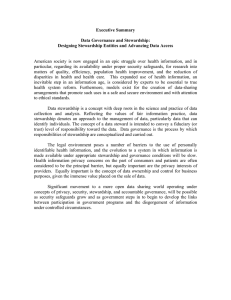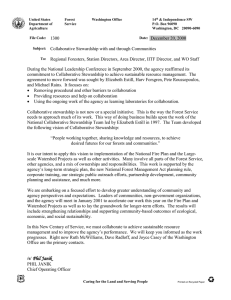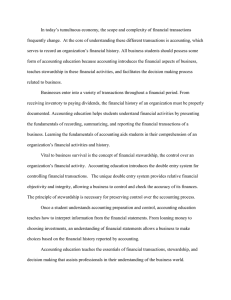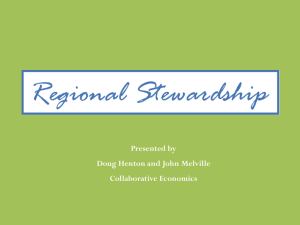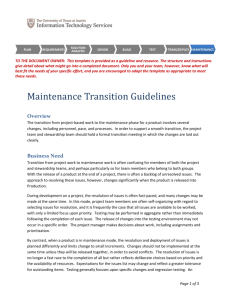Making Place Matter OKLAHOMA STATE REGENTS FOR HIGHER EDUCATION
advertisement
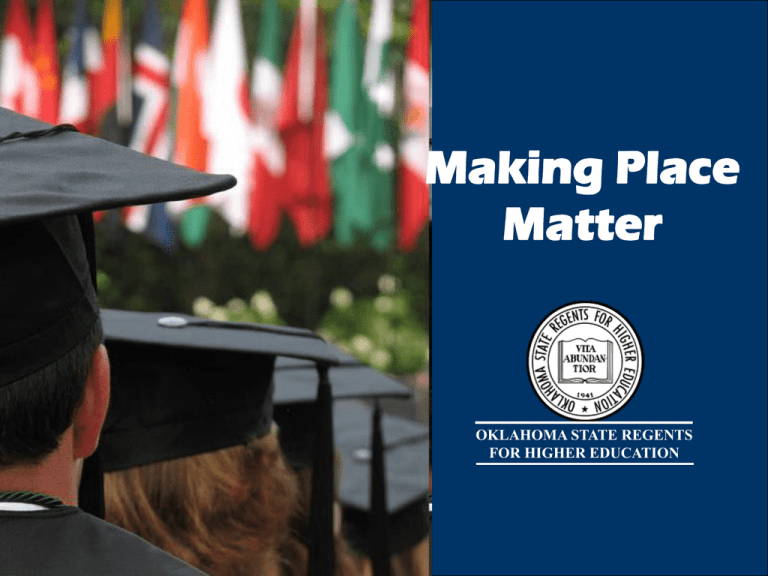
Making Place Matter OKLAHOMA STATE REGENTS FOR HIGHER EDUCATION Making Place Matter Project with the American Association of State Colleges and Universities (AASCU) AASCU Reviewed community engagement and regional stewardship literature Surveyed presidents Visited six institutions Developed conceptual scheme Public engagement is Place-related Interactive Mutually beneficial Integrated Regional Stewardship Regional stewardship is commitment to and work in support of the long-term economic and social success of a locale. It reflects the convergence of four “conversations”: innovative economy livable community social inclusion collaborative governance Regional Stewardship Framework Innovative Economy Preparing people and places to succeed Livable Community Preserving and creating places to live and work Social Inclusion Ensuring that everyone participates and shares responsibility Collaborative Governance Finding creative ways to govern Source: Alliance for Regional Stewardship HIGHER EDUCATION AS REGIONAL STEWARDS To From Stewards of Place 3 Pillars Service Research Teaching Ivory Tower 3 Pillars Engagement Innovation Learning HIGHER EDUCATION AS REGIONAL STEWARDS FROM TO Teaching Learning Research Innovation Service Shared Leadership TEACHING TO LEARNING FROM TO Classroom Classroom w/o walls Teaching inputs Educational outcomes One-way content delivery Two-way exchange Preparation of next generation Continuous preparation of all generations RESEARCH TO INNOVATION FROM Idea generation Individual inventions Single discipline focus Higher education institution-centered work TO Idea application Collaborative innovations Interdisciplinary focus Regional collaborations SERVICE TO SHARED LEADERSHIP FROM TO Episodic, short-term involvement Sustained, long-term involvement Tactical, individual contributions Strategic, institutional commitment Issue/cause focus Focus on community/ region well-being Accountability for services rendered Shared responsibility for results Boosting Stewardship Capacity STEP 1: Establish regional context STEP 2: Assess campus-system-state stewardship resources and capacity STEP 3: Develop goals and success measures STEP 4: Develop a stewardship roadmap STEP 1: Establish Regional Context Identify and diagnose the region, paying particular attention to the four conversations (innovative economy, livable community, inclusive society, collaborative governance) Identify and order stewardship priorities for the region Identify primary regional resources and capacity, focusing on top stewardship priorities. STEP 2: Assess University-System-State Resources Identify university/college resources and capacities that are currently applied (or could be applied) to top regional stewardship priorities. Assess policy/practice environments (campus-system-state) that help or hinder the institution’s regional application of resources and capacity to stewardship priorities. STEP 3: Develop Goals and Success Measures Identify target areas for stewardship initiatives and for institutionalization of top stewardship priorities. Establish success measures for top regional stewardship priorities. STEP 4: Develop Stewardship Roadmap STEP 1: ESTABLISH REGIONAL CONTEXT REGIONAL CHALLENGES INNOVATIVE ECONOMY Preparing people and places to succeed LIVABLE COMMUNITY Preserving and creating places to live and work SOCIAL INCLUSION Ensuring that everyone participates and shares responsibility COLLABORATIVE GOVERNANCE Finding creative ways to govern REGIONAL ASSETS REGIONAL OPPORTUNITIES REGIONAL PRIORITIES EXAMPLES OF REGIONAL CHALLENGES REGIONAL CHALLENGES INNOVATIVE ECONOMY Preparing people and places to succeed INNOVATIVE ECONOMY—primarily economically-driven concerns such as industry restructuring, job loss, entrepreneurship, commercialization of new technologies, climate for innovation LIVABLE COMMUNITY Preserving and creating places to live and work LIVABLE COMMUNITY—primarily quality-of-life driven concerns such as environmental quality, urban and neighborhood revitalization, land use, transportation congestion, housing, amenities SOCIAL INCLUSION Ensuring that everyone participates and shares responsibility COLLABORATIVE GOVERNANCE Finding creative ways to govern SOCIAL INCLUSION - primarily socially-driven concerns such as poverty, educational preparation, employment opportunity, community health, civic participation COLLABORATIVE GOVERNANCE - primarily problem-solving concerns such as the need for regional alliances of local jurisdictions, local/state/federal collaboration, and public-private partnerships to address complex regional challenges STEP 1: ESTABLISH REGIONAL CONTEXT REGIONAL CHALLENGES INNOVATIVE ECONOMY Preparing people and places to succeed LIVABLE COMMUNITY Preserving and creating places to live and work SOCIAL INCLUSION Ensuring that everyone participates and shares responsibility COLLABORATIVE GOVERNANCE Finding creative ways to govern REGIONAL ASSETS EXAMPLES OF ASSETS REGIONAL ASSETS—major regional collaborative initiatives, key public and/or private investments, major institutions that do or could address the challenge INSTITUTION ASSETS— leadership, expertise, major internal and externally focused initiatives, key investments/incentives/policies STEP 1: ESTABLISH REGIONAL CONTEXT REGIONAL CHALLENGES INNOVATIVE ECONOMY Preparing people and places to succeed LIVABLE COMMUNITY Preserving and creating places to live and work SOCIAL INCLUSION Ensuring that everyone participates and shares responsibility COLLABORATIVE GOVERNANCE Finding creative ways to govern REGIONAL ASSETS REGIONAL OPPORTUNITIES REGIONAL PRIORITIES STEP 2: ASSESS INSTITUTION/SYSTEM/STATE STEWARDSHIP CAPACITIES HOW IS THE INSTITUTION REGIONAL PRIORITIES CURRENTLY ENGAGED IN THESE PRIORITIES? HOW ELSE COULD IT BE ENGAGED? WHAT CHANGES ARE NEEDED FOR STRENGTHENING INSTITUTION ENGAGEMENT? STEP 3: DEVELOP GOALS & MEASURES REGIONAL PRIORITIES REGIONAL GOALS REGIONAL MEASURES STEP 4: DEVELOP REGIONAL STEWARDSHIP ROADMAP Oklahoma MPM: Past, Present, Future Presidents’ Orientation (June 17) Determine Regions, Choose Facilitators, and Forge Agreements to Work Together Among Higher Education Institutions in the Same Region (June-September) Facilitator Briefing Book and Training Session (October 1) Assemble Regional Team to Attend MPM Seminar (Team to include up to 12 institutional, business, and community partners) (September-October) MPM Seminar (October 29) Conduct regional conversations (November-April) Inventory current planning (January) Collect regional priorities (April-May)
